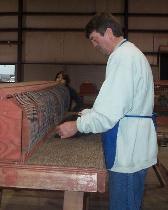Checking For Disqualifications
When the judge begins evaluating rabbits in a class, he or she generally begins by looking for disqualifications and getting a general idea of the class of rabbits. The judge will check each rabbit’s teeth, nails, gender, and perhaps eyes, testicles or for other disqualifications. At this point, judges will weigh rabbits who seem to be under or over the weight limit for Holland lops (2 lb. minimum, 4 lb. maximum). Judges use various methods for keeping track of their observations—and may change them from show to show. Some will place coins or chips in front of rabbits. Others will physically sort rabbits. It’s best not to guess how the judges are marking. You may have figured out their plan all wrong.
 Placing Rabbits
Placing Rabbits
Once the judge has gotten an idea of the field, non-placing rabbits, if the class is large enough to have them, are removed one by one. Then the judge will work through all the rabbits that do place in the class. The judge will call out the rabbit’s ear number. Until that time, it is important that you not indicate ownership of a particular rabbit. A judge should not be influenced, either positively or negatively, by considering the ownership of a rabbit. Once the number is called, you may move forward to hear the judge’s comments. The judge will give remarks on every rabbit that places.
What does the Judge Look For?
Licensed judges are trained to evaluate rabbits according to the ideal guidelines published by the ARBA. Rabbit shows are not based on the rabbits’ performance or personality, but rather on their physical conformance to the written standard. To learn what a judge is looking for, check out our section on Rabbit Judging Information.
Comment or Remark Cards
At some shows, comment cards may be completed for you, recording the gist of the judge’s evaluation. The comment card’s usefulness depends on the judge’s ability to clearly and completely articulate the opinion and the writer’s ability to record them quickly and accurately. You may decide to take your own notes, even when there is a writer recording comments. A clipboard makes that more convenient.
Taking Your Rabbit Off The Table
When the judge has finished making comments, you should remove your rabbit promptly. Leaving a rabbit on the table can confuse the judge and slows the evaluation, since the judge must often stop and figure out whether a rabbit has been placed already or still needs to be evaluated. Just be sure to take a moment and recheck the ear number. Occasionally breeders have removed the wrong rabbit from the table. The judge then places the remainder of the class in the same manner. Judging often slows when only the top five rabbits remain, but one by one, their ear numbers are called and they, too, are removed. The top five rabbits receive national breed club sweepstakes points, based on their placement and the number of rabbits shown. The first place rabbit is generally left on the table for further competition. Occasionally, a judge may decide to send back the first place rabbits until later if there is not enough room to keep them and judge the remainder of the classes.
![]()
Next Article: Next Stop, Best in Show!
